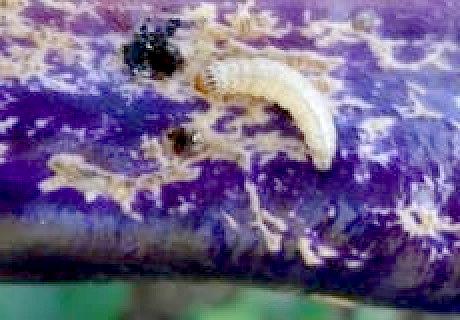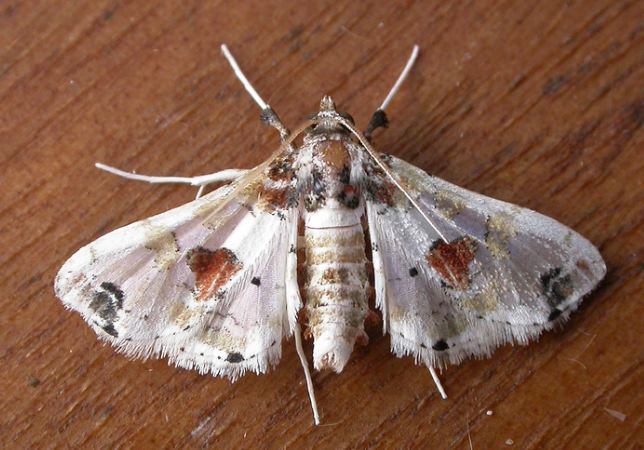
(Photo: courtesy of Barry Daniel Nourice,
Tamil Nadu Agricultural University and
Asian Vegetable Research and Development Center)
These Caterpillars are very fussy.
They are a world-wide pest, feeding only on the shoots and fruit of
Eggplants ( Solanum melongena,
SOLANACEAE ).
The caterpillars are white or pink,
with four dark dashes on the
prothorax,
and with four small pale brown warts on the back of each abdominal segment.
The head is brown.
The caterpillar leaves its foodplant to pupate elsewhere in a brown cocoon.

(Photo: courtesy of
Donald Hobern, Mission Beach, Queensland)
The adult moth is white with some yellow and some black markings,
and a reddish-brown splodge near the middle of each forewing.
The natural resting posture has the tail of the abdomen curled up and forwards.
The male moth has a wingspan of about 1.5 cms.
The female moth is larger with a wingspan of about 2 cms.

(Photo: courtesy of
Donald Hobern, Mission Beach, Queensland)
The species has been found in
India,
Nederlands,
Pakistan,
Philippines,
Seychelles,
South Africa,
as well as in Australia in
Queensland.
Control of this pest has been tried with:
planting the crop under netting,
destruction of borer damaged fruits at regular intervals, and
use of Neem and other plant extracts,
use of various artificial insecticides,
mass trapping using the pheromones,
use of the bacterium Bacillus thuringiensis subsp. kurstaki,
combination of various microbial extracts,
use of the parasitic wasp Eriborus sinicus ( ICHNEUMONIDAE ), and
breeding resistant varieties of Eggplant by crossing with Solanum macrocarpon.
Further reading :
Achille Guenée,
Deltoïdes et Pyralites,
in Boisduval & Guenée :
Histoire naturelle des insectes; spécies général des lépidoptères,
Volume 9, Part 8 (1854), p. 223, No. 187.
Buck Richardson,
Tropical Queensland Wildlife from Dusk to Dawn Science and Art,
LeapFrogOz, Kuranda, 2015, p. 40.
(written 3 April 2013, updated 6 August 2013, 23 January 2016)








